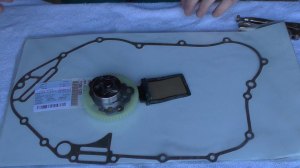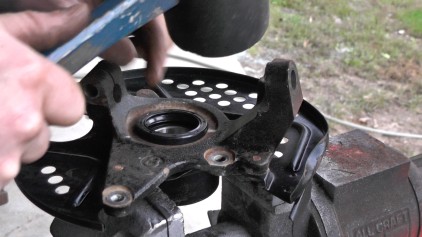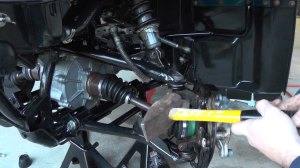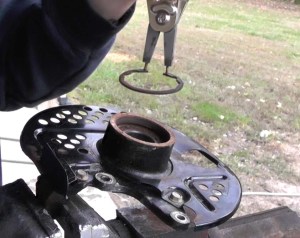Kawasaki 400 Bayou 4x4 oil pump not working? Replacement of the oil pump on the Bayou 400 may feel like a job the DIY can’t do. Having just completed the process of
diagnosing and fixing the problem I would recommend not to be
intimidated by the fix. It’s actually a straight forward process that
after watching the videos above and reading this article you will be
able to do. The longest part of the fix is waiting a couple days for
the parts to come in. To start with we will discuss some symptoms or problems that you may
have symptoms of before discovering the oil pump has went bad.
Unfortunately Kawasaki didn’t put a low oil pressure light on this quad.

- No oil in the oil filter
- excessive cam wear due to no lubrication
- excessive valve noise, clicking
What else could cause lack of lubrication:
- clogged oil line or banjo bolt
- faulty oil filter
- oil pre screen clogged or broke
Remember that the cylinder and piston is lubricated from oil in the
case, so a faulty oil pump will not show symptoms here. These
powerhouses hold nearly 4 quarts of oil, which for a atv of this size is
a great thing, as a lot is better than not enough. As soon as I
purchased my used 400 Bayou I changed the oil and found the oil filter
to be dry. Prior to purchasing I did notice that someone had been into
the head area by the generic silicone extruding from the head.
Basically I believe the previous owner had the cam replaced due to
excessive cam wear caused by lack of lubrication after the oil pump went
bad. There were signs they had pulled the oil pump, but probably
missed the problem.
My hands on explanation can be seen in this video.
If your Bayou is still showing peppy off idol response and starts easy
you have likely caught the problem before it ruined your cam, a $205
part.
What tools needed to access the oil pump:
- 8mm socket with extension
- 12mm socket
- 1 1/16 socket
- 22mm socket
- impact driver
- impact wrench
- something to hold clutch basket for removal, see video
- Puller of some type, see video

Start by removing all oil from the case and then removing the 8mm
bolts around the clutch side of the case. Remove the foot rest
assembly, six 12mm bolts. Remove outer clutch case carefully. Remove
the 1 1/16 nut on crankshaft, where cintrifical clutch is located and
pull clutch with puller (I used a 3 finger puller). After cyntrifical
clutch removed, pull gear behind it off. Next remove the clutch pack by
pulling the bearing in the center out and then using a 22mm socket to
remove the nut. After the nut is removed pull the clutch pack. Now you
can clearly see the oil pump, a plastic gear, powered by the
crankshaft. Remove the three screws holding the oil pump assembly with a
impact driver. Once the oil pump is pulled out you can start
diagnosing the issue. My total parts bill on this fix was $126.85 and time was approx 2 hours round trip (having to wait 4 days on parts between).
 Start by removing all oil from the case and then removing the 8mm
bolts around the clutch side of the case. Remove the foot rest
assembly, six 12mm bolts. Remove outer clutch case carefully. Remove
the 1 1/16 nut on crankshaft, where cintrifical clutch is located and
pull clutch with puller (I used a 3 finger puller). After cyntrifical
clutch removed, pull gear behind it off. Next remove the clutch pack by
pulling the bearing in the center out and then using a 22mm socket to
remove the nut. After the nut is removed pull the clutch pack. Now you
can clearly see the oil pump, a plastic gear, powered by the
crankshaft. Remove the three screws holding the oil pump assembly with a
impact driver. Once the oil pump is pulled out you can start
diagnosing the issue. My total parts bill on this fix was $126.85 and time was approx 2 hours round trip (having to wait 4 days on parts between).
Start by removing all oil from the case and then removing the 8mm
bolts around the clutch side of the case. Remove the foot rest
assembly, six 12mm bolts. Remove outer clutch case carefully. Remove
the 1 1/16 nut on crankshaft, where cintrifical clutch is located and
pull clutch with puller (I used a 3 finger puller). After cyntrifical
clutch removed, pull gear behind it off. Next remove the clutch pack by
pulling the bearing in the center out and then using a 22mm socket to
remove the nut. After the nut is removed pull the clutch pack. Now you
can clearly see the oil pump, a plastic gear, powered by the
crankshaft. Remove the three screws holding the oil pump assembly with a
impact driver. Once the oil pump is pulled out you can start
diagnosing the issue. My total parts bill on this fix was $126.85 and time was approx 2 hours round trip (having to wait 4 days on parts between).









